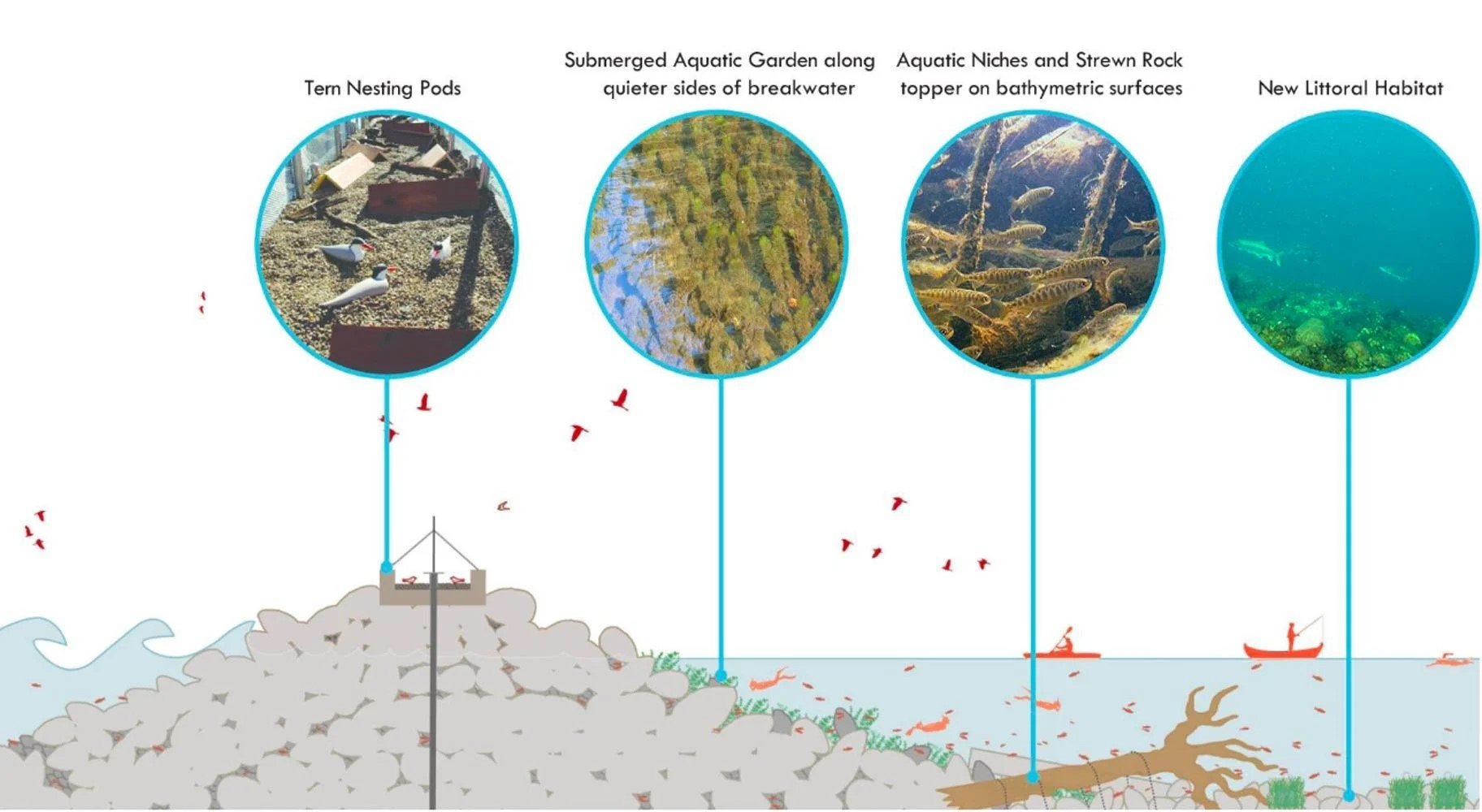Illinois Beach State Park (IBSP) now has islands. They’re actually breakwaters built as part of a $73 million project to create shoreline stabilization structures in three different locations in the park.
The park contains the last remaining undeveloped shoreline in Illinois, which is 6.5 miles long. However, the shoreline loses up to 100 feet per year as a result of erosion. Not only are parts of the shoreline disappearing, but upland panne wetlands and sand prairies have flooded with consequent sand deposits killing rare and endangered plant life. In some areas of IBSP, a flat beach now lies where three- to six-foot-tall dunes once stood. High waves from storms can over-wash vulnerable areas and deposit sand.
IBSP by John M Rich
The wave action of Lake Michigan is natural, and if sand buries one habitat, that can pave the way for another habitat to establish and flourish. However, concern over the speed and increasing impact with which these changes are occurring, along with the erosion of structures, paths and roads in IBSP, led to the implementation of the Illinois Beach State Park Shoreline Stabilization Project. Besides the Illinois Department of Natural Resources (IDNR) and the Capital Development Board, the partners involved in this project are Michels Construction, SmithGroup, Moffat & Nichol, Living Habitats, Edgewater Resources, and Collins Engineering.
There are now 22 stone breakwater structures in three different areas of IBSP. The planners expect these breakwaters to decrease wave energy before waves reach the shoreline and upland habitat, thus protecting these areas from severe ongoing erosion. The rough surfaces of the stone breakwaters will provide aquatic habitats for mudpuppies and yellow perch. Will newly stabilized beaches with more reliable connectivity between the shoreline and wetlands provide nesting habitats for shorebirds, such as Great Lakes Piping Plovers? Let’s hope so! This year the Waukegan pair and fledglings were seen foraging in IBSP.
Living Habitats, LLC
And what about the islands? Some of the 22 breakwaters will be visible from the shoreline during low lake levels. One of these breakwaters, viewable from 17th Street, hosts 10 steel nesting structures for Common Terns. These nesting structures, which are 10 feet in diameter and four feet deep, could hold six to seven nests each and include integrated components to deter predators. Steel cables are placed across the boxes to deter gulls from nesting. This particular breakwater was chosen as it is not near a heavily gull-inhabited part of IBSP, and not near locations popular with human visitors to the park. The structures are set upon a breakwater at roughly four feet over normal high-water lake levels, with the top rims eight feet above potential high lake levels. The nesting structures can be maintained and cleaned, and were placed on the breakwater this past summer.
Breakwaters near Winthrop Harbor/Michels Construction, Inc
The design and construction of the nesting structures are the result of research into other similar projects, revised for the extreme Lake Michigan environment. Further evaluation of the site and structures are required before the IDNR will start the process of luring Common Terns, which are endangered in Illinois, to the new nesting colony. One concern is that heat may be trapped within the structures, and so Brad Semel, an IDNR species recovery specialist, plans to install thermometers to monitor the temperature. Cameras will also be installed to monitor storm wave action and its impact on the nesting substrate within the structures.
Tern nesting structures, looking south/Living Habitats, LLC
The IDNR and other conservationists celebrated a successful 2024 nesting season for the Common Tern colony established at Great Lakes Naval Training Center. Much of what has been learned at that site over the years will be applied to the site at IBSP. If the new nesting structure environment is considered safe, decoys and call boxes will be used as attractants for Common Terns, conspecific attraction techniques that have been used at Great Lakes. We will have to wait until 2025 at the earliest to gauge their acceptance by terns.
Interior of tern nesting structure/Brad Semel
The ISBP Shoreline Stabilization Project began construction in 2023 and was completed in spring of 2024. It is the first freshwater project to earn WEDG® Verification. WEDG – Waterfront Edge Design Guidelines – is a national rating system and gold standard that encourages resilient, ecological and accessible waterfront design. Specialists in engineering, architecture and landscape architecture evaluated the project and gave it 146 out of 250 possible points, exceeding the requirements for Verification (130 are needed to pass). This is a great development for the birds, fish and vegetation that live along Lake Michigan.






